Are you struggling to specify the right surface finish for your plastic parts? Choosing the wrong texture can lead to a product that looks cheap, functions poorly, or inflates your tooling budget without reason. This uncertainty can be frustrating and costly. Understanding the SPI Finish Chart is the key to removing this guesswork, ensuring you get the exact look and feel you need while keeping your project on budget.
The SPI Finish Chart is a standardized system from the Society of the Plastics Industry that classifies mold surface textures into four main grades: A, B, C, and D. Grade A is a high-gloss, mirror polish achieved with diamond buffing. Grade B is a semi-gloss finish from fine emery paper. Grade C is a matte finish made with polishing stones, and Grade D is a rough, textured finish created by blasting. This chart provides a universal language for designers, engineers, and mold makers to communicate finish requirements accurately.
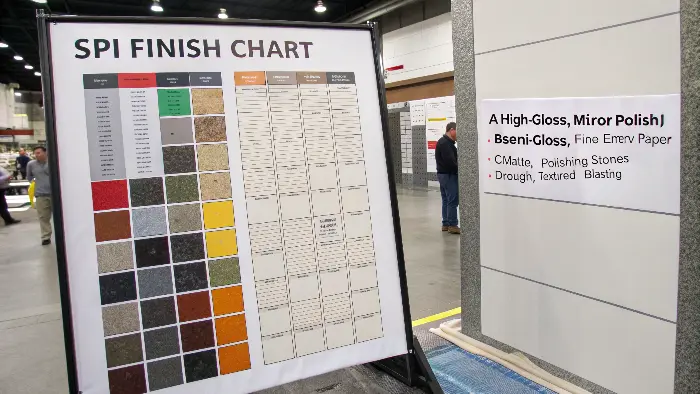
So, the chart gives us a common language for texture. But what do these letters and numbers actually mean for your part’s look, feel, and final cost? It’s one thing to see a code on a drawing, but another to understand how it translates to a real-world product. Let’s break down each category one by one, so you can see exactly how a simple specification impacts everything from aesthetics to your bottom line.
How Do You Read the SPI Finish Grades: From Diamond Polish to Blasted Textures?
Have you ever looked at a mold specification and felt confused by codes like A-1, B-3, or C-1? These terms can seem abstract, making it hard to visualize the final product. This confusion can easily lead to miscommunication with your supplier, resulting in parts that don’t meet your expectations. I’m here to break down what each grade means in simple, practical terms so you can communicate your needs with confidence.
To read the SPI chart, start with the letter, which defines the polishing method and general appearance. ‘A’ is for a mirror-like gloss from diamond buffing. ‘B’ indicates a semi-gloss finish using emery paper. ‘C’ represents a matte finish created with polishing stones. ‘D’ is for rough, non-cosmetic textures made by grit blasting. The number (1, 2, or 3) specifies the fineness within that grade, with ‘1’ being the smoothest or finest polish. For example, A-1 is the highest possible gloss, while D-3 is a very rough blasted texture.
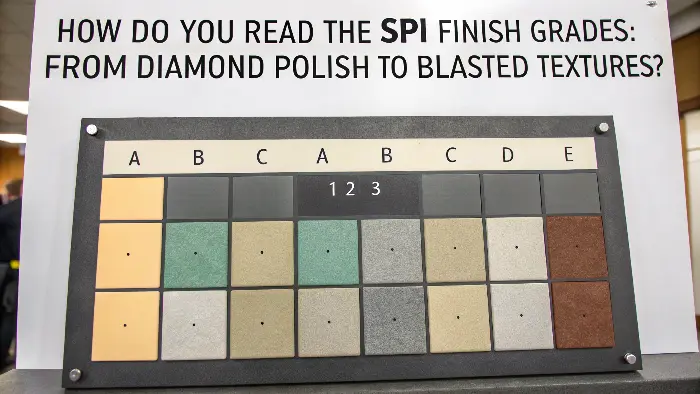
The SPI classification is the foundation for getting your part’s surface exactly right. It’s not just about looks; it’s about creating a clear, technical instruction for the mold maker. I’ve seen projects get delayed simply because the finish requirement was ambiguous. By understanding these grades, you take control of the conversation. Let’s dive deeper into what each grade entails, what it looks like, and where you would typically use it.
Grade A: The Mirror Finish
Grade A is the absolute top tier of mold finishes. It’s achieved through a meticulous, multi-step process where the mold steel is polished with fine diamond paste. The result is a flawless, mirror-like surface with no tool marks visible.
- A-1: The highest standard, a perfect gloss often called a "Grade #3 Diamond Buff."
- A-2: A slightly lower gloss, "Grade #6 Diamond Buff."
- A-3: The "lowest" gloss in the diamond category, "Grade #15 Diamond Buff."
These finishes are essential for parts where clarity is paramount, such as optical lenses, clear displays, and high-end cosmetic packaging. However, this level of perfection comes at a high price due to the intensive skilled labor required. In my experience, I once had a client who insisted on an A-1 finish for an internal, non-visible component. It added thousands to the mold cost for no functional benefit. We switched to a C-grade finish, saving them a significant amount of money without affecting performance at all.
Grade B: The Semi-Gloss Standard
Grade B finishes are a popular and practical choice for many consumer products. They are achieved by polishing the mold with fine-grit emery paper, which removes all machining marks but leaves a surface that isn’t a perfect mirror. It provides a clean, smooth appearance with a slight sheen.
- B-1: 600 Grit Paper
- B-2: 400 Grit Paper
- B-3: 320 Grit Paper
This finish is a fantastic middle ground. It offers a premium look without the extreme cost of a Grade A polish. You’ll find it on appliance housings, electronic enclosures, and many consumer goods where aesthetics matter but a mirror reflection isn’t necessary. It’s great at hiding minor imperfections like fingerprints and small scuffs.
Grade C: The Workhorse Matte
Grade C finishes are created using polishing stones, which leave a fine, uniform matte texture. These finishes are excellent for hiding minor cosmetic defects from the molding process, such as flow lines or sink marks.
- C-1: 600 Stone
- C-2: 400 Stone
- C-3: 320 Stone
I often recommend C-grade finishes for parts that are more functional than cosmetic, or for internal components. They provide a clean, non-reflective surface and are very cost-effective. Because the texture is less fine, the polishing process is much faster than for A or B grades. This makes it a great choice for industrial parts or products where a rugged, utilitarian look is acceptable.
Grade D: The Textured Grip
Grade D finishes are produced by dry blasting the mold cavity with abrasive materials like sand or glass beads. This creates a rough, textured surface. These finishes are not about looks; they’re about function.
- D-1: 240 Grit Blast
- D-2: #24 Grit Blast
- D-3: #11 Glass Bead Blast
The primary purposes of a D-grade finish are to provide grip, hide significant molding imperfections, or create a dull, non-reflective surface. You’ll see these textures on tool handles, the bottoms of containers, or other areas where a non-slip surface is needed. This is the fastest and cheapest finish to apply, as it involves a straightforward blasting process rather than hours of manual polishing.
| Grade | Polishing Method | Resulting Finish | Typical Application |
|---|---|---|---|
| A | Diamond Buff | Mirror-Gloss | Lenses, Reflectors |
| B | Emery Paper | Semi-Gloss | Consumer Electronics |
| C | Polishing Stone | Matte | Industrial Parts |
| D | Dry Blasting | Textured/Rough | Tool Grips, Bases |
Which SPI Finish is Right for Your Plastic Part’s Material and Application?
You know the different finishes, but how do you choose the right one for your specific project? Just picking a finish based on how it looks can lead to serious problems. The wrong choice could cause parts to stick in the mold, prevent paint from adhering properly, or simply be impossible to achieve with your chosen plastic material. The key is to think beyond aesthetics and consider the part’s function and material from the start.
Choosing the right SPI finish depends on function, aesthetics, and material. For optical parts like lenses (using PC or Acrylic), you need a high-gloss A-grade finish. For consumer electronics that need to look good and hide fingerprints, a B or C-grade matte finish is ideal. For parts that need grip or must hide molding marks, a D-grade texture is best. Critically, softer plastics like TPE cannot hold a high polish, while hard, amorphous plastics are perfect for it. Always match the finish to the material’s properties and the part’s end-use.
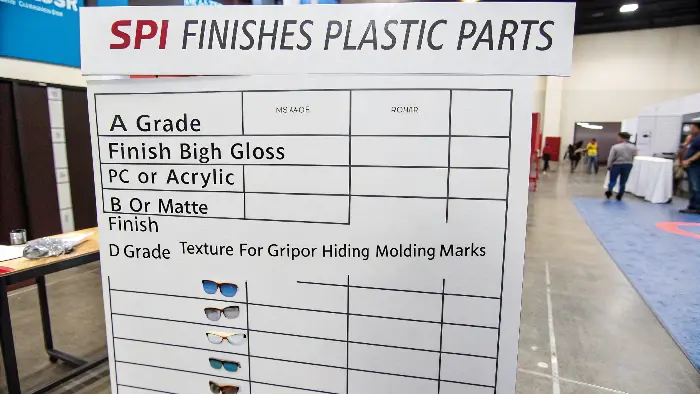
Thinking about these factors upfront is one of the most important steps in the design process. It prevents costly mistakes and ensures the final product performs as expected. For instance, you can’t expect a mirror finish on a part made from glass-filled nylon—the glass fibers will disrupt the surface. This is the kind of practical knowledge that bridges the gap between design and manufacturing. Let’s explore how to make the best choice by connecting the dots between your material, your application, and the finish.
Matching Finish to Plastic Material
Not all plastics are created equal when it comes to holding a surface finish. The properties of the resin play a huge role in what’s possible.
- Hard, Amorphous Plastics: Materials like polycarbonate (PC), acrylic (PMMA), and polystyrene (PS) are excellent for high-gloss A-grade finishes. Their structure allows them to replicate the mirror-like mold surface perfectly.
- Semi-Crystalline Plastics: Materials like polypropylene (PP), polyethylene (PE), and nylon (PA) have a crystalline structure that tends to scatter light, making a true mirror finish difficult. They are much better suited for B and C-grade finishes. Trying for an A-grade on PP is often a waste of money because the material itself won’t look like a mirror.
- Soft Elastomers: Soft plastics like TPE and TPU cannot hold a fine polish. Their flexible nature means they will conform to a rougher texture but won’t maintain a high gloss. D-grade or low C-grade finishes are more appropriate.
- Filled Plastics: Adding fillers like glass or carbon fiber dramatically impacts the surface. The fibers can create a "streaky" or rough appearance, making anything higher than a C or D-grade finish impractical and difficult to maintain as the abrasive fibers wear down the mold over time.
Functional Considerations: Beyond the Looks
The finish on your part does more than just look pretty; it has a job to do.
- Part Ejection: High-gloss (A-grade) and very smooth (B-grade) surfaces create more surface tension, which can make parts stick to the mold. To combat this, you need to ensure you have adequate draft angles. A slightly textured C or D-grade finish can actually aid in part release.
- Hiding Defects: This is a big one. A C-grade matte or D-grade textured finish is brilliant at hiding minor imperfections like sink marks, weld lines, and flow marks that are common in injection molding. A mirror-finish A-grade will highlight every single tiny flaw.
- Paint and Label Adhesion: If you plan to paint your part or apply a label, a perfectly smooth, glossy surface is not your friend. A light texture, like a C-grade or even a very fine D-grade finish, creates more surface area and gives the paint or adhesive something to "bite" into, ensuring better adhesion.
Aesthetics and Perceived Quality
Finally, consider the message the finish sends to your customer. A glossy A-grade finish on a cosmetic case screams "premium," but it also shows every fingerprint and scratch. For a product that will be handled frequently, like a TV remote, this can quickly make it look worn. A better strategy might be to use a B-2 semi-gloss on the main body and a D-1 texture on the sides for grip. This combination of finishes feels intentional and improves the user experience. I always advise clients to think about how the product will look after a month of use, not just when it comes out of the box.
How Does Your Choice of SPI Finish Directly Impact Mold Cost and Lead Time?
You want the best-looking part possible, but you’re also running a business with a budget. It’s easy to spec out a beautiful high-gloss finish on your design, but are you prepared for the cost? A higher finish level can dramatically increase your tooling costs and production timeline, sometimes catching you by surprise right before you approve the mold build. I’m going to explain exactly why this happens so you can make a smart, cost-effective decision.
The SPI finish directly impacts cost and lead time because higher finishes require exponentially more skilled labor and time. A D-grade blasted finish is quick and cheap. A C-grade stone polish takes more time and skill. A B-grade finish requires careful sanding with progressively finer paper. An A-grade mirror finish is by far the most expensive and time-consuming, demanding hours of meticulous diamond polishing by a master technician. Each step up in finish grade can add days or weeks and hundreds or thousands of dollars to your mold-making schedule.
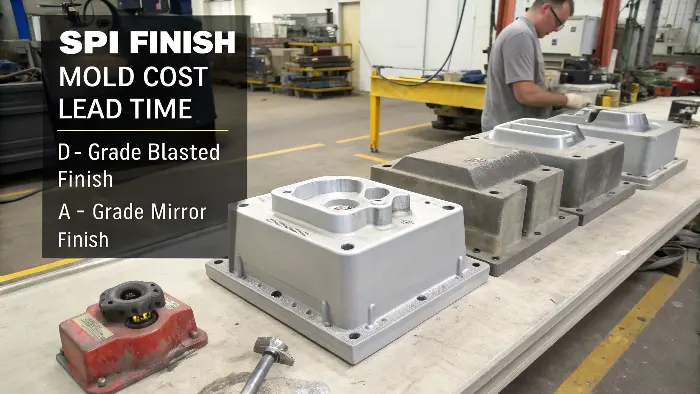
This isn’t about the cost of materials, like diamond paste or sandpaper. This is almost entirely about the cost of time and expertise. A great polisher is an artist, and their time is valuable. Understanding where that time goes will empower you to decide if that A-1 finish is a "must-have" or a "nice-to-have." Let’s break down the cost drivers and hidden factors you need to consider.
The Labor of Polishing: A Time-Consuming Art
Creating a surface finish isn’t an automated process; it’s a craft performed by hand. The journey from a machined steel block to a finished mold surface involves several stages.
- Machining: First, the mold cavity is cut using CNC machines. This leaves visible tool marks.
- Stoning (for C, B, A grades): The polisher starts with coarse stones to remove the deep machine marks, then works down to finer and finer stones. This is the foundation for all higher-level polishes. A C-grade finish stops here.
- Sanding (for B, A grades): For a B-grade finish, the polisher then moves to emery paper, starting with a coarser grit (like 320) and working their way down to a very fine grit (like 600). Each step must completely remove the scratches from the previous step.
- Diamond Polishing (for A grade): To achieve an A-grade mirror finish, the process continues with diamond paste applied to felt bobs. This is the most delicate and time-consuming stage, requiring immense patience and skill to create a flawless, reflective surface. An A-1 polish can take dozens of hours for even a small cavity.
Cost and Time Breakdown by Grade
To put it in perspective, let’s look at a relative comparison. This is just an estimate, but it illustrates the point clearly.
| SPI Finish Grade | Relative Polishing Time | Relative Cost Impact |
|---|---|---|
| D-Grade | 1x (e.g., 1-2 hours) | 1x (Baseline) |
| C-Grade | 2x-4x (e.g., 4-8 hours) | ~1.5x |
| B-Grade | 5x-10x (e.g., 10-20 hours) | ~2.5x |
| A-Grade | 15x-40x+ (e.g., 30-80+ hours) | 5x – 10x+ |
As you can see, the jump from a standard B-grade to a high-gloss A-grade is not a small step—it’s a huge leap in terms of labor investment. That A-1 finish could easily add over a week to your mold build lead time and increase the tooling cost by 20% or more.
Hidden Costs and Long-Term Maintenance
The costs don’t stop once the mold is built. High-polish A-grade molds are extremely delicate. They require more careful handling, cleaning, and storage to prevent scratches. A tiny scratch from a tool or a piece of debris can transfer to every part, forcing you to stop production and send the mold for re-polishing. This means production downtime and extra maintenance costs. A more robust C or D-grade finish is far more forgiving and requires less maintenance over the life of the tool. I’ve seen A-grade molds taken out of production for a full day just to fix a tiny scratch, halting an entire manufacturing line and costing far more than the initial polishing.
Beyond the Chart: How Do You Verify and Communicate Your Finish Requirements?
You’ve studied the chart and chosen a finish, like B-2, that seems perfect for your project. You’ve even marked it on your technical drawings. But how do you make sure the final parts you receive actually match that standard? What if your supplier’s idea of a "B-2" finish is different from yours? This ambiguity can lead to disputes and disappointment. I’ll share the best practices I use to ensure everyone is on the same page and you get exactly what you paid for.
To verify and communicate your SPI finish requirements effectively, never rely solely on a drawing callout. The most critical step is to request a physical finish plaque or a sample of polished mold steel from your supplier for each required texture. This becomes your "golden sample" for visual and tactile approval. You should also specify the measurable Surface Roughness (Ra) value in your drawings to provide a technical target. Clear communication using these physical and numerical standards is the best way to guarantee consistency and avoid misunderstandings.
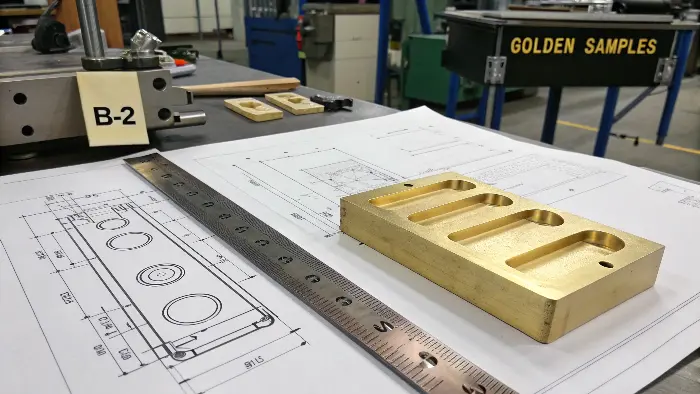
Relying on a code alone is like ordering a paint color from a name without seeing a swatch. It leaves too much room for interpretation. The goal is to remove all subjectivity from the process. By establishing clear, physical standards before production begins, you protect your investment and build a better relationship with your manufacturing partner. Let’s look at the actionable steps you can take to make this happen.
The Power of Physical Samples (Finish Plaques)
This is the single most important step you can take. Before your mold maker does the final polish on your expensive tool, ask them to prepare a small plaque of the same mold steel, polished to the exact SPI finish you specified. For example, if you need a B-2 and a D-1 finish on your part, ask for two separate plaques. They will send these to you for approval. You can see it, touch it, and hold it under the same lighting conditions where your final product will be viewed. This physical sample becomes the agreed-upon standard. Once you approve it, it serves as a physical contract. When you receive your first article parts from the mold, you compare them directly against this approved plaque. There’s no room for argument; either it matches, or it doesn’t.
Specifying Surface Roughness (Ra)
While the SPI chart is a great visual guide, it’s still somewhat subjective. To add a layer of objective, scientific measurement, you can specify the Surface Roughness Average (Ra) on your drawings. Ra is a number, measured in micro-inches (µin) or micrometers (µm), that quantifies the texture of a surface. A lower Ra value means a smoother surface. For example, you can specify "SPI B-2, Ra 10-12 µin." This gives the polisher a precise, measurable target to hit. They can use a tool called a profilometer to check their work and ensure it falls within your specified range. This removes all guesswork and is especially useful for high-tolerance or medical parts where consistency is critical.
Communication is Key: The Pre-Production Checklist
To tie it all together, follow this simple communication workflow to ensure success:
- Specify Clearly: Note the SPI code (e.g., SPI-B2) and the corresponding Ra value on all relevant surfaces in your 3D and 2D files.
- Discuss in DFM: During the Design for Manufacturability (DFM) review, have an explicit conversation with your mold maker about the required finishes. Confirm they understand and can achieve them. This is the time to discuss any potential issues with material choice or part geometry.
- Approve Physical Plaques: Do not allow the final mold polishing to begin until you have received and approved the physical finish plaques. Sign off on them and send a photo or scan back to the supplier.
- Inspect First Articles: When you receive the first parts from the new mold (often called T1 or FOT samples), use your approved plaques as the standard for inspection. Check them under good lighting to ensure the finish matches perfectly.
By following these steps, you create a closed-loop system of communication that protects you from costly errors and ensures your product looks and feels exactly as you designed it.
Conclusion
The SPI Finish Chart is more than just a technical document; it’s a vital communication tool that bridges the gap between your design intent and the final manufactured part. Understanding that each grade—from the mirror-like ‘A’ to the textured ‘D’—has a direct and significant impact on aesthetics, function, cost, and lead time is crucial. By choosing wisely and verifying your choice with physical samples, you can avoid overspending and ensure your product achieves the perfect balance of quality and value.
